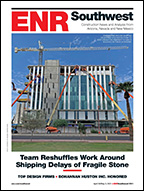Public transportation in Peru’s capital of Lima can be an intimidating affair. A bewildering cacophony of privately operated buses, minibuses and vans crisscross the city with men hanging out the doors, cajoling pedestrians to hop aboard. There is little respect for traffic rules. In an interview last year, Lima Mayor Luis Castañeda referred to city travel as “total and absolute chaos.”
But city officials are hoping to bring some order to that chaos later this month when they unveil Lima’s new $538-million integrated urban bus system, El Metropolitano. The project—known as the Segregated High-Capacity Corridor, or by its Spanish-language acronym COSAC—is being built by ProTransporte, a division of the city’s transportation department.
The transit system is designed to relieve congestion on Lima’s overloaded streets and worsening air quality by eliminating the existing system of privately run bus services. According to officials, there are more than 652 transit routes served by 464 different transit companies, many of which are informal businesses beyond the reach of regulation. However, the city has now stopped licensing new buses and ordered many older ones to be retired.
El Metropolitano will feature a 26-kilometer primary bus line built in the center lanes of the city’s main north-south arterial roads, with a fleet of 522 natural-gas-powered buses. The route’s first section, from a central terminal near the city’s historic center to the southern municipality of Chorrillos, will open in April, says Walter Paredes, ProTransporte’s head of works and maintenance. The northern leg from the main station to the municipality of Comas will begin operating in May.
The project includes construction of 35 intermediate stations, access ramps, yards and terminals as well as upgrading 50 km of roadways that will serve as feeder routes to the main bus line. Its centerpiece is the $18-million, 2,500-sq-meter underground central station in the heart of Lima’s historic district. Located beneath the Promenade of Naval Heroes, it is designed to handle 110,000 passengers a day up to a maximum of 15,000 at any given time.
Lima has invested almost $300 million in El Metropolitano with loans from the World Bank and the Inter-American Development Bank. There is also $240 million in private investment, primarily through concessions for bus-service and ticketing operations.
The idea of a city-run bus transit system with a subterranean central station was first proposed in 1967, but financial hurdles and social disturbances hampered work for years. An urban transportation master plan completed in 2004 proposed an integrated system of bus lines and electric trains modeled after the successful TransMileno system in Bogota, Colombia. Lima’s program retains that system’s use of exclusive busways and a network of terminals that feature pre-payment and level bus boarding. Feeder lines served by conventional buses augment the primary lines, featuring articulated buses.
The next step in integrating urban transport in Lima is construction of a $410-million electric train that will run 11.7 km from the city center to the southernmost municipality of Villa de Salvador. In December, a consortium of Brazilian construction firm Odebrecht and Peruvian contractor Graña y Montero bested two other contenders to win the job, set for completion in July 2011. ProTransporte is already examining the second phase of the project: a route originating in the port city of Callao, crossing through the central station and terminating in the municipality of Santa Anita.













Post a comment to this article
Report Abusive Comment